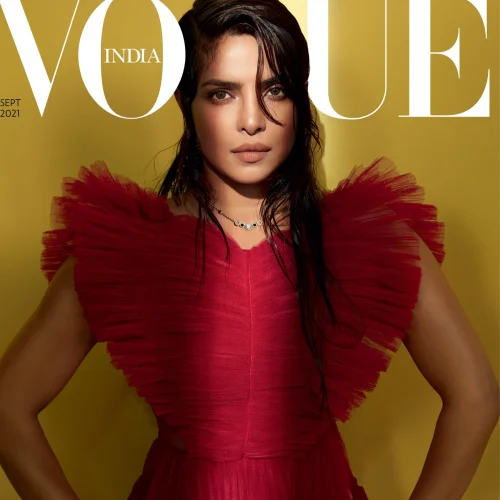
On August 31st 2021, Priyanka Chopra Jonas graced the cover page of the September edition of VOGUE magazine. Adorning a stunning red Christian Dior tulle dress, she was seen sporting a diamond-studded “mangal sutra” by Bvlgari, an Italian luxury brand. Jonas took to her Instagram account to announce the partnership between her and Bulgari exclusively for the Mangalsutra. She describes it as an “elegant and chic” design for “the modern Indian woman who takes charge of her own life”. Mauro Di Roberto, the Managing Director of the Jewelry Business Unit at Bvlgari calls the mangal sutra “a perfect marriage between tradition and modernity”, a statement that resonates with Priyanka Chopra Jonas’s Instagram post.
While the description makes the jewellery piece comes across as a mix of a trademark Indian thing with a modern and international twist, it calls for interrogation into what Priyanka Chopra Jonas is promoting as traditional Indian. Looking into the social and cultural connotations of a Mangalsutra, it seems that the glittery diamond laden mangal sutra hides the grim reality of caste and gender-based inequality prevalent in the Brahmanical Indian society.
Mangalsutra literally translates to “Sacred Thread” and is an important part of a Hindu wedding. Typically consisting of a gold pendant and a string of black beads, it is one of the five markers that distinguish married Hindu women from unmarried Hindu women. A Hindu groom ties it around the neck of a bride to finalise the wedding ceremony.
The idea and significance of Mangalsutra along with other markers signifying the marital status of women is rooted in Brahmanical patriarchy. Social scientist Uma Chakravarti describes Brahmanical Patriarchy as “The need for effective sexual control over women to maintain not only patrilineal succession but also caste purity, the institution unique to Hindu society”. To understand the implication of this, one must keep in mind that the Hindu society is rigidly endogamous, that is they marry within their own castes. In 1918, Dr Bhimrao Ambedkar in his essay “Castes in India: Their Mechanism, Genesis and Development” deduced that the sustenance and perpetuation of caste-based hierarchies take place through the subjugation of women by denying them agency and choice to choose their partners from different castes. Hindu law books Manusmriti and the Yajnavalkya Smriti espouse the idea that leaving women free and independent to make choices will lead to adversities and disturbances in Hindu society. Women in Hindu society are accorded the status of a commodity that gets transferred from father to husband, and it reflects in the marriage rituals and markers prescribed to a married woman under the guise of tradition.
Dalit Feminists like Urmila Pawar have argued that Mangalsutra signifies the marital status of Hindu women and also symbolically conveys a bride to be the property of her husband. She also says that Mangalsutra is symbolic of a woman’s status as a dependent and submissive other in Hindu society. Thus, Mangalsutra needs to be rejected, not glorified.

So, being a global celebrity of Indian origin, what is Priyanka Chopra promoting and when she calls it especially designed for the modern Indian women, which women is she referring to?
It is imperative that Indian women with caste and class privilege and large social following such as Priyanka Chopra critically assess the problematic aspects of their tradition. The Mangalsutra like any other Brahmanical marker serves as a tool of both caste and gender-based oppression. By promoting a Mangalsutra as a modern and empowering piece of jewellery, Jonas has done nothing but perpetuate the paradoxical idea of women being subordinates on whose oppression the caste system thrives.
As Priyanka Chopra is someone who is a global figure and is vocal about human rights and gender-based inequality, it becomes her duty to use her platform more responsibly. One must remember that even if a cage is made of gold, it still remains a cage!

However, this is not the first time that a brand has tried to modernise mangal sutra in order to market their diamonds. In a recent Sabyasachi Mangalsutra campaign which was in controversy and taken down for all the wrong reasons, the new luxury mangal sutra line intended to showcase “inclusivity and empowerment”(as stated by the brand in an Instagram post). The ad was supposed to be progressive in including the image of a woman and man intimately, the woman wearing the signature tiger emblazoned mangal sutra just above her cleavage. The campaign also included images of LGBTQ couples wearing the mangal sutra.
The larger question here, however, is can ‘Mangal Sutra’ be modernised? A symbol that inherently holds deeply patriarchal, oppressive and casteist meanings. While celebrities like Priyanka Chopra and luxury brands like Sabyasachi can afford to sell Mangal Sutras as accessories, for women in India mangal sutra still serve as a symbol of commodification, oppression and casteism. For them, it is far far away from luxury.

